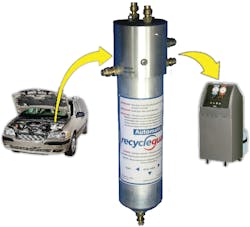Vehicle Application: 2003 Expedition 5.4L with rear A/C
Customer Concern:
The front A/C is not blowing cold. The blend door actuator has been replaced and the temperature does change when changing the setting, so the blend door is moving. The rear A/C blows cold as it should.
Tests/Procedures:
- Check the temperature of the lines to the front evaporator with the engine running and A/C on.
- If the lines are not both cold as they should be, verify the proper system charge.
- If the system is charged as it should be and the rear A/C is working as it should, suspect a faulty front expansion valve.
Tools used for this service:
- Electronic leak detector
- Leak detection dye
- Pressure gauges
- Non-contact temperature gun
- Refrigerant identifier
- Sealant detector
Poor or uneven A/C performance is often caused by broken air blend doors or faulty controls. However, if those are working correctly, the most likely culprit is the refrigerant system.
In vans and SUVs with dual A/C, the most common refrigerant system problem is a clogged expansion valve. This can be caused by a broken desiccant bag, contamination, or by debris left in the system after a compressor failure. In the problem described here, the front A/C isn’t working properly, but that’s not always the case. If refrigerant flow to the rear evaporator is even partially restricted for a long time, oil drops out and accumulates in the low spots of those long lines, eventually causing another compressor failure. The best way to avoid this is to make sure both front and rear A/C systems are working properly.
Measuring Line Temperatures
The best tool for checking refrigerant line temperature is a non-contact infrared thermometer. It lets you measure the temperature of something you can see but can’t reach. There are many on the market, including a new class of (relatively) low-cost thermal imagers that literally creates a color picture of heat. A refrigerant line can present a small target in a confined space, so thermometers with a laser pointer are easier to use. To get the most from these tools, it helps to understand how they work.
Every object emits infrared radiation (IR), and its intensity is affected by its temperature and the material it’s made from. A material’s ability to radiate energy is referred to as “emissivity.” Although an over simplification, in this case it’s safe to say that white or shiny materials have lower emissivity and dull or black materials have higher emissivity. A clean aluminum A/C line has lower emissivity than a black steel bracket.
Why does this matter? When aiming an infrared thermometer at materials with low emissivity, the sensor may also ‘see’ heat radiating from nearby objects with high emissivity. A laser pointer helps minimize the error. You can boost the emissivity of the light-colored aluminum line by wrapping a piece of black tape around it. By comparing the temperature readings of the bare line and the taped section, you’ll have some idea of the error you can expect when measuring parts of the line you can’t tape.
The detection pattern of an IR thermometer is shaped like a cone: The farther away from the sensor, the bigger the area ‘seen’ by the sensor. Specifications for the thermometer will tell you the distance-to-spot ratio (D:S), the size of the measured area at a given distance. In general, if the sensor is no more than 24 inches from the target, background radiation will have a minimal affect on the accuracy of the reading.
Checking System Charge
The only way to verify system charge is to recover and weigh the refrigerant. But if you suspect a clogged expansion valve, sometimes that can be detected with pressure gauges. Either way, before connecting anything to the system, first check for sealant and identify the refrigerant.
Sealant detectors work by creating an extremely small leak for a specific period of time and watching a flow meter. If sealer is present, it will seal the leak and reduce the flow. If this happens, make sure your recovery/recycle machine is protected with a sealant separator.
Next you’ll want to identify the refrigerant in the system. If it’s not pure R134a, your pressure gauge readings may not match your pressure/performance chart.
A new generation of electronic refrigeration system analyzers is available. They display things like low-side and high-side pressures, min/max pressures, vapor and liquid saturation temperatures, calculated superheat and subcooling, and a pressure/time chart of what’s happening in the system. There are other features too, but one of the most important is data logging of all these readings and calculations. The data can be downloaded to a computer for printing or importing to a work order.
If system pressure or charge is low, it’s time to look for leaks. There are two tools for this; dye and electronic leak detectors.
Dye Leak Detection
Dye added to the refrigerant will show up at the site of the leak under ultra-violet (UV) light. In most systems, only 1/8 ounce of dye is required, but don’t add dye before checking to see if it’s already there. Some vehicles have dye installed at the factory, or dye may have been added during a previous repair. Look for a “dye added” sticker somewhere under the hood. If you used a sealant detector as noted earlier, dye will show up in the flow meter too.
Excess dye is bad for two reasons. First of all, dye is carried by oil, not refrigerant, and some dye oils interfere with lubrication. The easiest way to avoid this is to use dye that meets Society of Automotive Engineers (SAE) Specification J2297. Secondly, dye fluoresces at its maximum brilliance at a specific dilution ratio, so excess dye won’t shine as brightly under UV light. Your dye injector must be accurate and precise, and you really should use it as instructed.
UV lights, whether powered internally or by the vehicle battery, are quite powerful. Most UV lights and/or dyes come with colored glasses. These not only protect your eyes from UV radiation, they also enhance the fluorescence of the dye by as much as 40 percent. Use the glasses.
With dye in the system, start the engine and run the A/C for at least 5 minutes, then start looking for leaks. Check carefully around all joints and fittings, especially the service port caps, and don’t forget the evaporator case drain. A very small leak may not appear for a few days, so you may have to ask the customer to come back next week. If you find a leak, don’t assume it’s the only one; check the entire system.
After completing your repairs, use the dye cleaner supplied in the kit to remove any dye stains that are visible, and don’t forget to affix a “dye installed” sticker somewhere under the hood. This will prevent confusion if A/C service is required in the future.
Electronic Leak Detection
An electronic leak detector works with the engine not running, as long as system pressure is at least 50 psi. The newest detectors built to SAE Standard J2791 can find leaks as small as 0.15 oz (4 grams) per year.
Using this tool effectively takes time, patience, and attention to detail. The tool must be kept clean and the replaceable sensor tip and batteries must be in good condition. Many are sensitive to some common underhood fluids and require periodic calibration/reset during use. Some will reset automatically.
Refrigerant is heavier than air, so it’s important to check below the line/fitting and, if possible, inside the evaporator case drain tube. By carefully following the user manual, and with practice, this important tool will tell you the size of the leak as well as location.
An automotive air conditioning system is designed to blow air that’s 25 to 35 degrees cooler than the outside ambient temperature. When everything is working correctly, you should see the same vent temperatures on both the front and rear A/C systems. If front and rear performance are not the same, these tools can help you find out why.
Thanks to Jeff Prickett of Bright Solutions International, Paul DeGuiseppi of the Mobile Air Conditioning Society, and Ritchie Engineering for their contributions to this article.
Vehicle Application:
|
2003 Expedition 5.4L with rear A/C |
Customer Concern:
The front A/C is not blowing cold. The blend door actuator has been replaced and the temperature does change when changing the setting, so the blend door is moving. The rear A/C blows cold as it should.
Tests/Procedures:
1. Check the temperature of the lines to the front evaporator with the engine running and A/C on.
2. If the lines are not both cold as they should be, verify the proper system charge.
3. If the system is charged as it should be and the rear A/C is working as it should, suspect a faulty front expansion valve.
Tools used for this service:
- Electronic leak detector
- Leak detection dye
- Pressure gauges
- Non-contact temperature gun
- Refrigerant identifier
- Sealant detector
About the Author

Jacques Gordon
Jacques Gordon is the former editor-in-chief of PTEN and Professional Distributor magazines. His background includes 10 years as an automotive technician and 10 years in Tier 1 suppliers’ engineering labs testing gaskets, fuel injection systems and emission control systems.
He continues to stay abreast of the latest technical developments through editorial research and technician training seminars. He holds an ASE Master Technician with L1 Certification and a Master Hybrid Technician certification from ACDC.
Jacques has been writing for aftermarket magazines since 1998, and he has earned a reputation as one of the best technical writers in the business. He is a winner of two American Society of Business Press Editor awards and several company editorial awards.
He is currently the video script writer for the CARS Training Network in Ontario, Canada.
Connect with him on LinkedIn.
